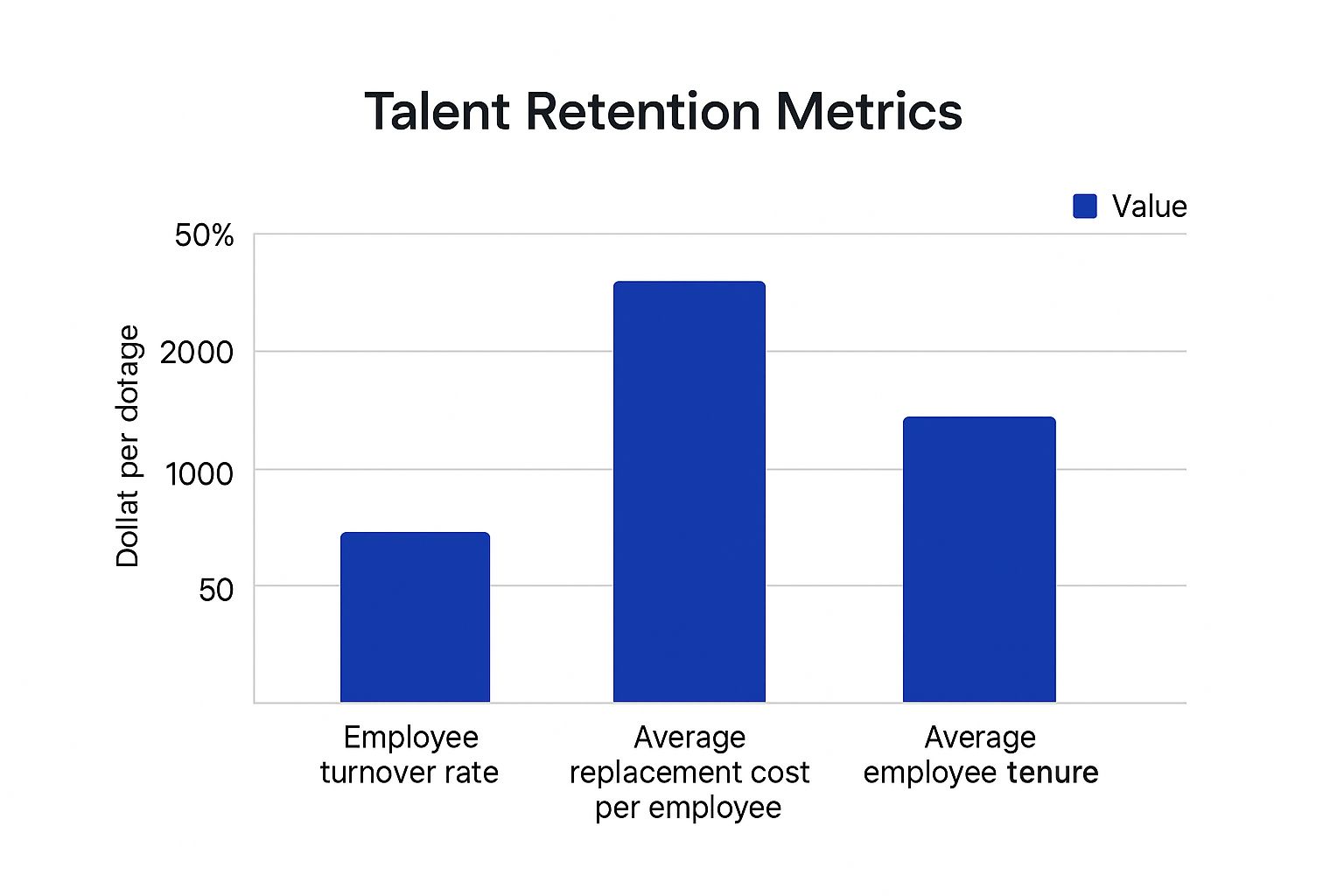Talent retention is your company's game plan for keeping your best people from walking out the door. It's less of a defensive HR number and more of a proactive business strategy. Think of it like a top-tier sports team doing everything it can to make sure its star players want to stay for the long haul.
Unpacking Talent Retention and Why It’s So Critical
So, what is talent retention, really? At its heart, it’s the sum of all the efforts an organisation makes to create a place where top performers genuinely want to stay and build their careers. This goes way beyond just throwing a competitive salary at someone. It’s about building a supportive, engaging workplace that fosters loyalty and makes looking elsewhere seem far less appealing.
This whole concept is a core piece of effective human resources management, focused entirely on keeping valuable people inside the organisation. Picture your company as a finely tuned machine; your best employees are the critical gears that keep it running smoothly. When you lose even one, it can throw the whole system out of sync, causing friction, delays, and a noticeable dip in performance.
The Real Cost of Letting Retention Slide
For businesses in the UK, the stakes are incredibly high right now. Recent data shows a pretty alarming trend: nearly half of all employees (48%) are thinking about quitting their jobs in the next year. This isn't just a headache for the HR department; it's a massive financial risk.
Replacing an employee can cost anywhere from 30% to a staggering 200% of their annual salary. If you take a role with a £37,400 salary, that’s a potential hit of £11,200 to nearly £75,000. It's a powerful reminder of how learning programmes can bolster your retention strategy.
But the financial sting is only part of the story. High turnover sends ripples through the entire company.
- Morale Takes a Nosedive: When people see their colleagues leaving one after another, the remaining staff can feel demotivated, anxious, and overworked.
- Knowledge Walks Out the Door: Departing employees take years of valuable, hard-won institutional knowledge with them—the kind you can't just write down in a handover document.
- Productivity Slumps: New starters need time to get up to speed. In the meantime, the existing team has to pick up the slack, which often leads straight to burnout.
In essence, a strong retention strategy isn't just about keeping people. It's about preserving the knowledge, stability, and positive culture that are the bedrock of business success. It's what separates thriving companies from those that are always playing catch-up.
The True Cost of Losing Your Best People

High employee turnover is far more than just an HR headache. Think of it as a slow leak in your company’s engine—it's a serious drain on your financial health, operational stability, and overall momentum.
When a valued team member hands in their notice, the immediate costs of replacing them are just the tip of the iceberg. You see the recruitment fees and the advertising spend, but these figures often distract from the deeper, more damaging consequences happening just below the surface.
Beyond the Balance Sheet: The Hidden Costs
This is where the real damage is done. The indirect costs of turnover are the subtle, cascading effects that can quietly dismantle a team's effectiveness and erode your competitive edge. Getting a handle on these hidden costs is the first step to truly understanding why retaining talent matters so much.
These less obvious expenses include:
- Loss of Institutional Knowledge: When a seasoned employee walks out the door, they take years of role-specific expertise and deep-seated company knowledge with them. This is that invaluable "how we really get things done here" wisdom that you'll never find written down in a manual.
- Decreased Productivity: Let's be realistic, a new hire needs time to get up to speed. It can often take months for them to reach the same level of productivity as the person they replaced. In the meantime, the rest of the team is left to pick up the slack, which can easily lead to burnout and a drop in output across the board.
- Damaged Team Morale: High turnover creates a palpable sense of instability. The colleagues left behind can start to feel overworked, undervalued, or even anxious about their own job security. Before you know it, morale and engagement have taken a nosedive.
The impact of losing experienced staff is profound. Understanding the true cost of losing your best people extends beyond direct financial outlays; it also includes the significant intellectual capital and institutional knowledge, exemplified by articles discussing the swift loss of valuable company experience.
The Ripple Effect on Your Business
The departure of just one key person can disrupt client relationships that took years to build, tarnish your brand's reputation, and stifle innovation simply because your teams are constantly in flux.
To truly grasp the financial hit, it's worth exploring a detailed breakdown of the cost of employee turnover to see just how quickly these expenses stack up. Ultimately, you have to start seeing talent retention for what it is: a critical business strategy, not just an HR function. It’s absolutely essential for long-term, sustainable success.
Understanding Why Great Employees Leave

It’s easy to assume that when a great employee hands in their notice, it’s all about the money. While compensation is definitely part of the equation, the real reasons your top talent starts looking elsewhere are usually far more nuanced and tied directly to their day-to-day experience. Getting to grips with these drivers is the first real step in building a retention strategy that actually works.
Think of it like an emotional bank account. Every time an employee has a positive experience—a manager who listens, a project that sparks their passion, a simple thank you for a job well done—they make a deposit. But every negative experience—feeling overlooked, constantly overworked, or professionally stuck—is a withdrawal. When that account runs low, a slightly better salary offer from another company is all it takes for them to pack their bags.
The Impact of Career Stagnation
One of the quickest ways to drain that loyalty account is by letting careers go stale. Your most ambitious and talented people need to see a path forward within your organisation. If they look up from their desk and see a dead end rather than a clear route for growth, they’ll naturally start looking for another road.
And this isn't just about promotions and new job titles. It’s about the chance to learn new skills, tackle exciting challenges, and simply feel like they're getting better at what they do. Stagnation is a huge motivator for job hunting, especially in the UK, where career progression is the number one reason people decide to look for a new role.
A stagnant career path is a clear signal to your best people that their growth isn't a priority. If you aren’t investing in their future, another company will gladly do so.
This really shines a light on how crucial professional development is for any serious talent retention effort.
Burnout and a Toxic Work Environment
Another major reason people head for the exit is the environment itself. A culture defined by chronic stress, impossible workloads, and a non-existent work-life balance will wear down even the most committed employee. Burnout isn't just about feeling a bit tired; it's a deep-seated state of emotional and physical exhaustion that destroys engagement and poisons productivity.
The stark reality is that workplace stress has a massive impact on retention. In fact, a staggering 70% of UK employees say at least one aspect of their job causes them stress. This problem gets even worse when there's no support system in place, like poor mental health resources or rigid, inflexible working hours. You can discover more insights about UK talent retention on achievers.com to understand these challenges in more detail.
At the end of the day, people want to work for companies where they feel seen, supported, and respected. When the culture turns toxic or the demands become unreasonable, it’s not a question of if your best people will leave, but when. Truly improving what is talent retention for your business means taking a hard look at these core, human elements of work.
How to Measure What Truly Matters
If you want to get a real grip on talent retention, you have to start with the numbers. Relying on gut feelings or office whispers just won't cut it. To move from thinking you have a problem to knowing exactly where and why you’re losing great people, you need solid data.
Think of these key metrics as your company's health check. They give you a clear, objective look at the stability of your workforce, letting you spot issues before they spiral out of control. Without these figures, you're flying blind, unable to see if your efforts are working or to make a case for new strategies.
This image shows how closely related different retention metrics are, from turnover rates and their costs to the average time an employee stays with you.

As you can see, when one metric like turnover goes up, it tends to drag others along with it, creating a chain reaction that can really hurt the business.
Starting with the Foundational Metrics
To get started, you need a baseline. This means getting to grips with two fundamental figures: your overall retention rate and your turnover rate. Together, they give you a bird's-eye view of who is staying versus who is leaving over a specific period, usually a year.
It's a straightforward but powerful comparison:
- Employee Retention Rate: This is simply the percentage of your team who were with you at the start of a period and were still there at the end. It’s your headline success score.
- Employee Turnover Rate: The flip side of the coin. This shows the percentage of employees who left during that same period. This is your primary red flag.
Calculating these gives you a starting point. For instance, if you see a consistently low retention rate year after year, it’s a clear signal that something in your employee experience is broken and needs fixing—fast.
Digging Deeper for Actionable Insights
Knowing your overall numbers is a good start, but the real magic happens when you slice the data. The broad turnover rate tells you that you have a problem; segmented data tells you where the problem is. This is how you find insights you can actually act on.
A high overall turnover rate tells you the house is on fire. A high turnover rate under a specific manager tells you exactly which room to aim the fire extinguisher at.
Think about breaking down your turnover data in these ways:
- By Department or Manager: This is often the most revealing cut. If one team has a revolving door of staff while others are stable, it’s a strong indicator of localised issues, such as poor leadership, a toxic micro-culture, or an unmanageable workload.
- Voluntary vs. Involuntary Turnover: It's crucial to know if people are choosing to leave or if you're asking them to. A high voluntary turnover rate is a direct reflection on your company culture, management quality, and overall job satisfaction. It’s the one to watch.
- By Performance Level: Are your star players leaving, or are you losing your underperformers? Losing top talent is incredibly damaging and suggests you aren't providing the growth, recognition, or challenges they need to stay engaged.
Tracking these metrics gives you a much clearer picture of what's going on inside your organisation. The table below breaks down some of the most essential ones to keep an eye on.
Essential Talent Retention Metrics Explained
By measuring what truly matters, you can move beyond guesswork and build a talent retention strategy that is precise, effective, and backed by hard evidence.
Actionable Strategies to Retain Top Talent
https://www.youtube.com/embed/NvjLpTBqOdM
Knowing why people leave is one thing, but actually stopping them from walking out the door is a whole different ball game. To really get a grip on talent retention, you need a deliberate, hands-on approach that makes your company a place where great people genuinely want to build their careers.
The trick is to stop playing defence—scrambling when a resignation letter lands on your desk—and start playing offence. This means building an environment that meets your team's core needs long before they even dream of browsing job boards. It all boils down to three key pillars: real career growth, a supportive culture, and rewards that actually matter.
Invest in Meaningful Career Paths
One of the biggest reasons top performers quit? They feel like they've hit a ceiling. Ambitious people need to see a future for themselves at your company. If they feel stuck in a dead-end role, they’ll naturally start looking for their next challenge elsewhere. It’s human nature.
Putting money and effort into career development sends a clear signal: you believe in your team's potential. UK talent retention statistics back this up, showing that 93% of employees are more likely to stay with a company that invests in their careers. What's more, businesses with high retention see a 22% bump in profitability, proving that investing in your people pays off on the bottom line.
Here are a few ways to put this into practice:
- Structured Mentorship Programmes: Pairing junior staff with experienced leaders is a classic for a reason. It fast-tracks skill development and forges stronger internal connections, making everyone feel more invested.
- Clear Development Plans: Sit down with each employee and map out where they want to go. Regular check-ins keep these plans alive and ensure everyone is moving forward.
- Upskilling Opportunities: Offer access to relevant courses, workshops, and certifications. This helps your team grow in ways that benefit both their own ambitions and the company's goals.
Cultivate a Supportive and Flexible Culture
Your company culture is the invisible glue holding everything together. A positive, supportive one is a magnet for talent, while a toxic atmosphere will send your best people running for the hills. This all starts with psychological safety—creating a space where people feel safe enough to speak up, share ideas, and give honest feedback without fear.
A critical part of keeping talent actually starts before day one. A fantastic first impression is vital, and you can get guidance with your 7-step onboarding process checklist.
In today’s world, flexibility is no longer a perk; it’s a must-have. Acknowledge that your employees have lives outside the office and trust them to manage their time. Offering hybrid models or flexible hours can make a world of difference to work-life balance and help prevent burnout. You can find more ideas for building this kind of culture in our guide on how to improve employee retention.
Design Recognition and Rewards That Motivate
Nothing kills motivation faster than feeling invisible. While a competitive salary is the baseline, true recognition goes way beyond the payslip. A good recognition programme makes people feel seen and valued for what they specifically bring to the table.
For recognition to hit the mark, it needs to be:
- Timely: Don’t wait for the annual review. Acknowledge great work right when it happens.
- Specific: "Good job" is nice, but "The way you handled that client's difficult request saved the account" is powerful. Explain what was done well and the impact it had.
- Public and Peer-to-Peer: Foster a culture where colleagues celebrate each other. This not only reinforces great work but also strengthens team bonds.
By weaving these practical strategies into the fabric of your organisation, you'll do more than just talk about talent retention—you'll turn it into one of your greatest competitive advantages.
Common Questions About Talent Retention

As you start to really dig into building a workplace people love, a few common questions always seem to pop up. It's easy to get tangled up in the details, but the core ideas behind keeping your best people are actually quite simple. Let’s tackle some of the most frequent queries we hear from managers and business leaders.
The aim here is to cut through the noise and give you practical, straightforward answers. By clearing up these common points of confusion, you can build a culture that holds onto its talent with more confidence and clarity.
Is Talent Retention Just About Paying More?
This is easily the biggest myth out there. While you absolutely have to offer fair, competitive pay, it’s rarely the thing that makes someone stick around for the long haul. Think of salary as the price of admission—it gets you a seat at the table, but it won't win you the game.
Real, lasting retention is built on something much deeper. If someone feels like they’re stagnating, can't stand their manager, or is completely burnt out, a pay rise is just a sticking plaster on a much bigger wound. Another company can always come along and offer a bit more money, but what they can't easily copy is a fantastic culture where people feel genuinely valued and see a clear path forward.
In short, you can definitely lose people over poor pay, but you can't keep them with pay alone. It's the engagement, the growth opportunities, and the sense of belonging that forge real loyalty.
How Does Employee Engagement Relate to Retention?
Employee engagement and talent retention are two sides of the same coin. They’re intrinsically linked. Engagement is all about an employee's emotional investment in their work, their team, and the company's mission. Retention is simply the result of getting that engagement right.
An engaged employee is switched on, motivated, and often goes above and beyond because they truly care. They aren't just clocking in and out; they’re actively invested in the company's success. That deep connection is one of the most powerful indicators of whether someone will stay or start looking elsewhere.
- High Engagement: Naturally leads to higher retention, better productivity, and even happier customers.
- Low Engagement: A huge warning sign. It often precedes high turnover, more sick days, and a general dip in morale across the team.
When you focus on boosting engagement—through open communication, meaningful recognition, and development opportunities—you are directly investing in your retention efforts. For a closer look at this dynamic, it’s worth exploring different employee retention strategies that have engagement at their core.
Can Small Businesses Really Compete for Talent?
Absolutely. It’s a common worry, but smaller businesses have secret weapons that can be incredibly appealing to top performers, even if they can't match a corporation's salary budget. What they lack in deep pockets, they can make up for with agility, community, and impact.
Here's how smaller businesses can punch above their weight:
- Offer Greater Impact: In a small team, one person’s contribution is far more visible and can directly shape the company's future. That sense of ownership is a massive motivator.
- Foster a Tighter Culture: It’s easier to build close-knit, family-like relationships in a smaller group. That feeling of true belonging is tough for a huge company to replicate.
- Provide More Flexibility: With less bureaucracy, small businesses can be more nimble. This often translates into more flexibility in job roles, responsibilities, and work arrangements.
By leaning into these natural strengths, small businesses can create a compelling proposition that goes way beyond the payslip. This focus on culture and personal impact is a key part of answering the question of what is talent retention in any business, big or small.

